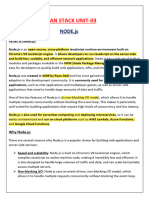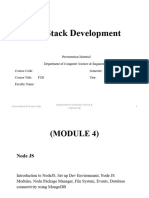Simple nodejs project
Uploaded by
saiakkinaSimple nodejs project
Uploaded by
saiakkinaCertainly! I'll provide you with a simple directory structure for a Node.
js project
that includes both frontend and API backend files. You can use this structure as a
starting point for your project.
Here's the basic layout:
```
my-nodejs-project/
├── backend/
│ ├── index.js # Backend API logic
│ └── package.json # Backend dependencies
├── frontend/
│ ├── index.html # Frontend HTML
│ ├── styles.css # Frontend CSS
│ ├── app.js # Frontend JavaScript
└── package.json # Project-level dependencies
```
Here's a description of each file and directory:
1. `backend/`: This directory contains the backend API logic.
- `index.js`: Your Node.js server code for handling API requests.
- `package.json`: This file lists the backend dependencies.
2. `frontend/`: This directory contains the frontend files.
- `index.html`: Your main HTML file for the frontend.
- `styles.css`: CSS styles for your frontend.
- `app.js`: JavaScript code for your frontend application.
3. `package.json`: This is the project-level `package.json` file. It lists
dependencies for the whole project, including both frontend and backend. It might
also include scripts for running your project locally or deploying it.
Here's a simplified example of how the `package.json` files might look:
For the backend (`backend/package.json`):
```json
{
"name": "backend",
"version": "1.0.0",
"main": "index.js",
"dependencies": {
"express": "^4.17.1" // Example backend dependency
}
}
```
For the frontend (`frontend/package.json`):
```json
{
"name": "frontend",
"version": "1.0.0",
"dependencies": {},
"scripts": {
"start": "http-server" // Example script to start a local server
}
}
```
For the project root (`my-nodejs-project/package.json`):
```json
{
"name": "my-nodejs-project",
"version": "1.0.0",
"scripts": {
"start": "concurrently \"cd frontend && npm start\" \"cd backend && node
index.js\""
},
"dependencies": {
"http-server": "^0.12.3", // Example project-level dependency
"concurrently": "^7.0.0" // Example project-level dependency
}
}
```
In this example, you can use the `npm start` command at the project root to
concurrently start both the frontend and backend components.
Keep in mind that this is a basic setup. Depending on your project's complexity and
requirements, you might need to add more features like routing, API endpoints, data
storage, and more.
You might also like
- Angular Workshop: From Beginner to Pro, Creating Applications for the Real WorldFrom EverandAngular Workshop: From Beginner to Pro, Creating Applications for the Real WorldNo ratings yet
- JAVASCRIPT FRONT END PROGRAMMING: Crafting Dynamic and Interactive User Interfaces with JavaScript (2024 Guide for Beginners)From EverandJAVASCRIPT FRONT END PROGRAMMING: Crafting Dynamic and Interactive User Interfaces with JavaScript (2024 Guide for Beginners)No ratings yet
- Create A Single Page Website Using Node - Js and Express - Js - by Ankit Maheshwari - JavaScript in Plain English - MediumNo ratings yetCreate A Single Page Website Using Node - Js and Express - Js - by Ankit Maheshwari - JavaScript in Plain English - Medium8 pages
- Firebase Storage for Angular: A reliable file upload solution for your applicationsFrom EverandFirebase Storage for Angular: A reliable file upload solution for your applicationsNo ratings yet
- FULL - STACK - LAB - MANUAL (CS337) For StudentNo ratings yetFULL - STACK - LAB - MANUAL (CS337) For Student31 pages
- It3511 - Full Stack Web Development - Faculty - ManualNo ratings yetIt3511 - Full Stack Web Development - Faculty - Manual117 pages
- Setup Node.js Express Project_ A Beginner's GuideNo ratings yetSetup Node.js Express Project_ A Beginner's Guide13 pages
- Mastering Node.js Web Development: Go on a comprehensive journey from the fundamentals to advanced web development with Node.jsFrom EverandMastering Node.js Web Development: Go on a comprehensive journey from the fundamentals to advanced web development with Node.jsNo ratings yet
- How to Become a Good JavaScript with node.js developerNo ratings yetHow to Become a Good JavaScript with node.js developer6 pages
- Terraform to attach a security group to an EC2 instanceNo ratings yetTerraform to attach a security group to an EC2 instance1 page
- Experience in the implementation of OOPsNo ratings yetExperience in the implementation of OOPs1 page
- Display Only the Date Part of the Ingestion TimeNo ratings yetDisplay Only the Date Part of the Ingestion Time1 page
- Caution required while grouping in KustoNo ratings yetCaution required while grouping in Kusto1 page













































































